Jasca Ducato (talk | contribs) |
m (While ACReb doesn't say reales explicitly, it was Spain's currency from 1350s–1864.) Tag: Visual edit |
||
| Line 7: | Line 7: | ||
==Major currencies== |
==Major currencies== |
||
The following represented the major currency of the region, during their respective time periods: |
The following represented the major currency of the region, during their respective time periods: |
||
| − | *[[Drachma |
+ | *[[Drachma]]e in [[Greece]] during the [[Peloponnesian War]],<ref>''[[Assassin's Creed: Odyssey]]''</ref> and in Ptolemaic [[Egypt]].<ref name="ACO">''[[Assassin's Creed: Origins]]''</ref> |
*{{Wiki|Florin (Italian coin)|Florins}} in [[Renaissance]] [[Italy]].<ref name="AC2">''[[Assassin's Creed II]]''</ref><ref name="ACB">''[[Assassin's Creed: Brotherhood]]''</ref> |
*{{Wiki|Florin (Italian coin)|Florins}} in [[Renaissance]] [[Italy]].<ref name="AC2">''[[Assassin's Creed II]]''</ref><ref name="ACB">''[[Assassin's Creed: Brotherhood]]''</ref> |
||
*{{Wiki|Akçe}} in the 16th century [[Ottoman Empire]].<ref name="ACR">''[[Assassin's Creed: Revelations]]''</ref> |
*{{Wiki|Akçe}} in the 16th century [[Ottoman Empire]].<ref name="ACR">''[[Assassin's Creed: Revelations]]''</ref> |
||
| − | *{{Wiki|Spanish real|Reales}} during the [[Golden Age of Piracy]] in the [[Caribbean|West Indies]] |
+ | *{{Wiki|Spanish real|Reales}} during the [[Golden Age of Piracy]] in the [[Caribbean|West Indies]]<ref name="AC4">''[[Assassin's Creed IV: Black Flag]]''</ref> and the ''[[Reconquista]]'' in [[Spain]].<ref>''[[Assassin's Creed: Rebellion]]''</ref> |
| − | *{{Wiki|Pound sterling|Pounds sterling}} in [[United States|Colonial America]]. People also paid with [[Spain|Spanish]], [[France|French]], and [[Portugal|Portuguese]] coins, {{Wiki|wampum}}, or colony-specific bills, but it was simplified to |
+ | *{{Wiki|Pound sterling|Pounds sterling}} in [[United States|Colonial America]]. People also paid with [[Spain|Spanish]], [[France|French]], and [[Portugal|Portuguese]] coins, {{Wiki|wampum}}, or colony-specific bills, but it was simplified to pounds sterling in the [[Animus|Animus 3.0]] and [[Helix]].<ref name="AC3">''[[Assassin's Creed III]]''</ref><ref name="ACRG">''[[Assassin's Creed: Rogue]]''</ref> |
*{{Wiki|Écu}} in Colonial [[Louisiana]].<ref name="AC3L">''[[Assassin's Creed III: Liberation]]''</ref> |
*{{Wiki|Écu}} in Colonial [[Louisiana]].<ref name="AC3L">''[[Assassin's Creed III: Liberation]]''</ref> |
||
*{{Wiki|French livre|Livres}} in [[Paris]], France, before and after the [[French Revolution]].<ref>''[[Assassin's Creed: Unity]]''</ref> |
*{{Wiki|French livre|Livres}} in [[Paris]], France, before and after the [[French Revolution]].<ref>''[[Assassin's Creed: Unity]]''</ref> |
||
| Line 39: | Line 39: | ||
==18th century== |
==18th century== |
||
| − | During the Golden Age of Piracy in the Caribbean, [[Piracy|pirate]] [[Captains|captain]] and [[Assassins|Assassin]] [[Edward Kenway]] would trade goods such as sugar, [[Rum|rum]], wood, metal, and cloth (the latter three of which could be used to upgrade his [[Ships|ship]], the ''[[Jackdaw]]'') he acquired from captured vessels and floating cargo to [[Harbormasters|harbormasters]] in return for Spanish Reales. He also commanded a [[Kenway's |
+ | During the Golden Age of Piracy in the Caribbean, [[Piracy|pirate]] [[Captains|captain]] and [[Assassins|Assassin]] [[Edward Kenway]] would trade goods such as sugar, [[Rum|rum]], wood, metal, and cloth (the latter three of which could be used to upgrade his [[Ships|ship]], the ''[[Jackdaw]]'') he acquired from captured vessels and floating cargo to [[Harbormasters|harbormasters]] in return for Spanish Reales. He also commanded a [[Edward Kenway's fleet|fleet]] that traded with cities all across the [[Atlantic Ocean|Atlantic]]. |
[[File:ACIII-TrainingBegins 5.png|thumb|250px|Achilles showing Homestead's ledger to Connor]] |
[[File:ACIII-TrainingBegins 5.png|thumb|250px|Achilles showing Homestead's ledger to Connor]] |
||
Revision as of 14:05, 20 March 2019

|
Patience, brothers. Soon we will reveal the secrets of Assassin's Creed IV: Black Flag, Assassin's Creed: Rogue, Assassin's Creed: Unity, Assassin's Creed: Syndicate, Assassin's Creed: Origins and Assassin's Creed: Odyssey . This article has been identified as being out of date. Please update the article to reflect recent releases and then remove this template once done. |
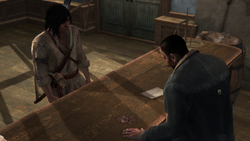
Connor trading with a merchant in Boston
An economic system refers to the transactions and trade that individuals partake in. Most notably, through interaction with the economy, money can be earned to purchase items such as weapons and equipment from merchants, via the fulfillment of assassination contracts, pickpocketing, hiring thieves, looting treasure chests, or other more legitimate means.
Major currencies
The following represented the major currency of the region, during their respective time periods:
- Drachmae in Greece during the Peloponnesian War,[1] and in Ptolemaic Egypt.[2]
- Florins in Renaissance Italy.[3][4]
- Akçe in the 16th century Ottoman Empire.[5]
- Reales during the Golden Age of Piracy in the West Indies[6] and the Reconquista in Spain.[7]
- Pounds sterling in Colonial America. People also paid with Spanish, French, and Portuguese coins, wampum, or colony-specific bills, but it was simplified to pounds sterling in the Animus 3.0 and Helix.[8][9]
- Écu in Colonial Louisiana.[10]
- Livres in Paris, France, before and after the French Revolution.[11]
- Pounds sterling in London, United Kingdom, during the Victorian era.[12]
15th century
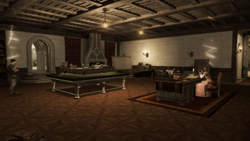
The Villa Auditore's workshop
Banks were an essential part of everyday Renaissance life. Ezio Auditore da Firenze came from a family of bankers, and by investing in renovating Monteriggioni, he and his sister Claudia received a share of the profits.[3] Ezio used the money to pay for the following:
- Services offered by blacksmiths, doctors, and tailors
- Hiring mercenaries, courtesans, and thieves
- Bribing heralds
- Purchasing paintings - thus improving the value of the Villa Auditore - and maps from art merchants to find treasure chests
- Lessons from mercenaries on how to use long weapons and heavy weapons, as well as advanced application of throwing knives
- Caravan travel
Thieves would also attempt to rob Ezio; in the event that money had been stolen from him, Ezio could tackle or kill the thief to get it back.[3]
16th century
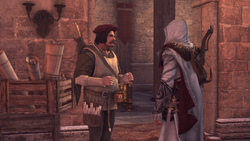
Ezio speaking with an architect in Rome
During the liberation of Rome, Ezio generated income by lending money to reopen shops and faction buildings, repair aqueducts, restore sewer tunnels, and buy shares in landmarks.
He could also find exotic items in chests around the city to trade for special upgrades from the stores in Tiber Island, and repurchase the inventions of Altaïr Ibn-La'Ahad's Codex from Leonardo da Vinci. Upon restoring the city of Rome completely, Ezio was reunited with the Auditore cape for his efforts.[4]
When Ezio arrived in Constantinople, many shops were closed after the Byzantines had captured the Assassin Dens and the surrounding area. By recapturing a Den, Ezio could reopen the shops, banks and faction buildings, and they would remain open even if the Templars reoccupied a Den. However, should the Templars ever do so, there would be an additional 15% tax cost on all items that could be bought.[5]
Ezio could then use the money earned by his share in Constantinople's shops to renovate other cities reclaimed from the Templars, increasing his daily payment of akçe. He could also increase his revenue by purchasing items from book shops, improving the value of the library in Galata headquarters. During his time in the city, he learned to use bombs and began buying them from black market dealers, and received ingredients from his apprentices in other cities, once they had surveyed the region for the Master Assassin Piri Reis.[5]
18th century
During the Golden Age of Piracy in the Caribbean, pirate captain and Assassin Edward Kenway would trade goods such as sugar, rum, wood, metal, and cloth (the latter three of which could be used to upgrade his ship, the Jackdaw) he acquired from captured vessels and floating cargo to harbormasters in return for Spanish Reales. He also commanded a fleet that traded with cities all across the Atlantic.
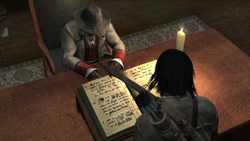
Achilles showing Homestead's ledger to Connor
The economy of the American colonies in the 18th century were based around the crafting and trading of goods. Connor and Aveline de Grandpré earned money by arranging the transportation of materials and goods. Connor typically obtained many goods by hunting or buying them from the residents of the Davenport Homestead,[8] while Aveline could purchase and resell materials via her family's shipping business.[10]
Profits made through land or naval convoys were determined by where and which merchant or port they traded with, with naval convoys earning more than than those sent to Boston, New York, or the Frontier via land routes.[8][10]
Lance O'Donnell could craft a total of three land convoys, with a maximum capacity of eight items to trade per convoy, and three naval convoys with a maximum capacity of fifteen tradeable items. Liberating forts and undertaking privateer contracts in the Aquila made the trade routes safer, lowering the risk percentage as well as lowering taxes.[8]
For example, the risk of a naval convoy being attacked dropped from 80% to 5% after the Aquila had cleared the route. In the event of the convoy being attacked while on the road, Connor would be notified that it was in danger, and had to defend it himself or send his recruits to do so, otherwise the profits would be lost. There was nothing that could be done if a naval convoy was lost at sea however.[8]
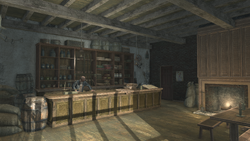
Interior of a general store
Unlike Renaissance Italy, general stores provided all the items Connor needed. He could make money by selling them his hunting spoils, the value and quantity of which depended on how the animal was killed.[8]
Game slain by a single strike of an arrow, poison darts or the Hidden Blade was worth more than spoils slashed or shot by a weapon multiple times, such as firearms, trip mines, and rope darts, which ruined pelts and skins. The Aquila could also be upgraded with purchases made from harbormasters, making the vessel a more formidable force for Connor during privateer contracts.[8]
Trivia
- While conventional trade was unavailable in Assassin's Creed: Bloodlines, upgrades for Altaïr Ibn-La'Ahad could be purchased by finding Templar coins.
References
- ↑ Assassin's Creed: Odyssey
- ↑ Assassin's Creed: Origins
- ↑ 3.0 3.1 3.2 Assassin's Creed II
- ↑ 4.0 4.1 Assassin's Creed: Brotherhood
- ↑ 5.0 5.1 5.2 Assassin's Creed: Revelations
- ↑ Assassin's Creed IV: Black Flag
- ↑ Assassin's Creed: Rebellion
- ↑ 8.0 8.1 8.2 8.3 8.4 8.5 8.6 Assassin's Creed III
- ↑ Assassin's Creed: Rogue
- ↑ 10.0 10.1 10.2 Assassin's Creed III: Liberation
- ↑ Assassin's Creed: Unity
- ↑ Assassin's Creed: Syndicate
| |||||||||||||||||||||||||||||||||||||
| ||||||||||||||||||||||||||||||||||||||||
